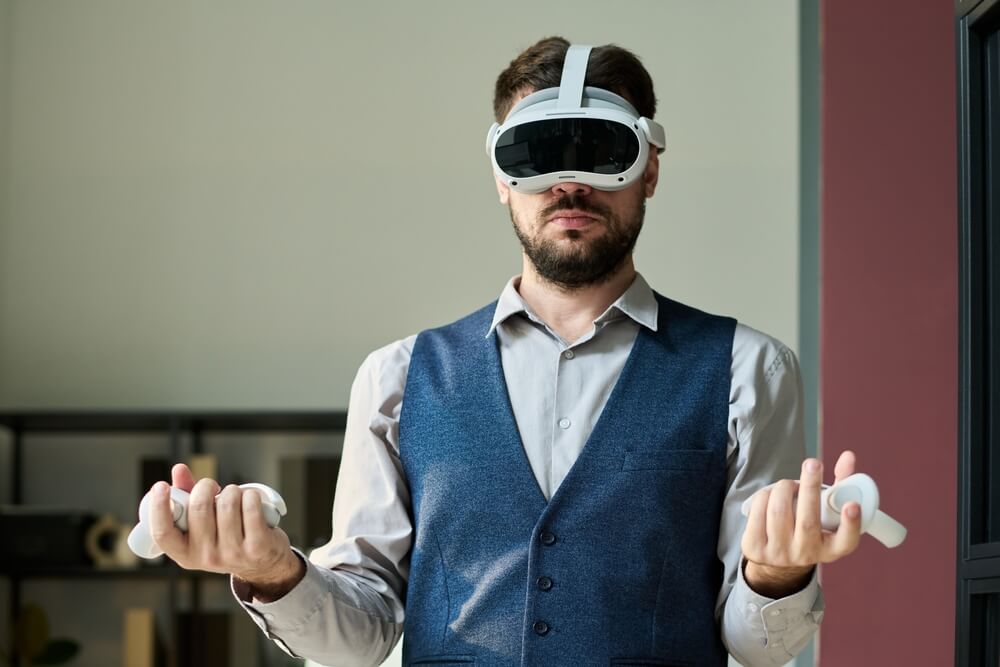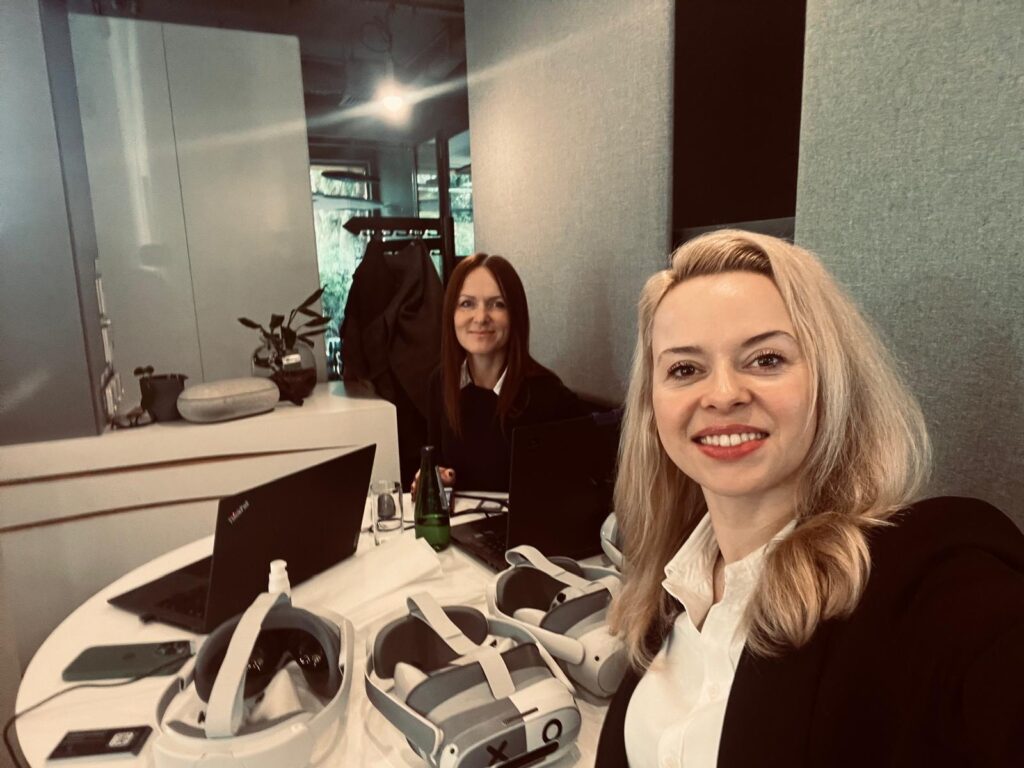Safety Tips for VR Training
Table of Contents:
Virtual Reality (VR) training has transformed how businesses educate and empower their employees. It offers realistic, repeatable experiences without real-world consequences. But while the technology minimizes many operational risks, it brings its own set of safety considerations. That’s why understanding and implementing the right safety tips for VR training is simply a must. Let’s explore the most important precautions to take when setting up and delivering VR training sessions.
Key Takeaways:
- Safe environment is essential:
Clear training spaces of obstacles like furniture, cords, or uneven flooring to reduce the risk of accidents. - Prepare participants properly:
Brief users on how to use VR equipment, set expectations, and provide guidance on exiting simulations safely. - Monitor physical comfort:
Watch for signs of motion sickness, dizziness, or fatigue. Offer regular breaks and allow gradual acclimation to VR. - Maintain hygiene and hardware:
Clean shared headsets and controllers after each use and regularly check equipment for damage or wear. - Support psychological safety:
Intense scenarios can overwhelm users—always debrief, encourage feedback, and provide emotional support post-training. - Ensure accessibility:
Offer seated modes, subtitles, or voice commands so all employees, including those with disabilities, can safely participate. - Holistic approach drives results:
Combining physical, emotional, and technical safety creates a secure environment that enhances engagement and learning outcomes.
Understanding the risks before you plug in
It’s important to remember that during VR training, users are fully immersed in a virtual environment – a state known as “presence.” While this makes the experience highly effective, it also means they may lose awareness of their real-world surroundings, increasing the risk of accidental bumps, trips, or falls without proper safety measures.
One of the most fundamental safety tips for VR training is to designate a safe training space. This means clearing the area of any physical obstacles such as furniture, cords, or uneven flooring. A spacious, open area is necessary for training scenarios that involve movement, reaching, or turning. It helps ensure both safety and freedom of motion.
Preparing participants the right way
As you probably know, VR training isn’t the same as sitting through a slideshow. It’s interactive, often physical, and can be intense – especially for users who are new to immersive environments. Before handing over a headset to users, walk them through what to expect, how to operate the controllers, and how to exit the simulation if needed.
Another key aspect of safety tips for VR training is screening for sensitivity. Some people may be prone to motion sickness, dizziness, or disorientation, especially during fast-moving or high-simulation experiences. To ensure you build a safe, positive experience, offer breaks between sessions and encourage users to speak up if they feel unwell.
Also, make sure every user understands how to signal for help or pause the session. This might mean training facilitators to monitor sessions and intervene if someone appears unsteady or confused.
Equipment hygiene and maintenance
In any training environment, hygiene is a basic necessity. But in VR, where headsets make direct contact with users’ faces and are often shared among multiple people, sanitation is even more essential. One of the often-overlooked safety tips for VR training is cleaning the equipment thoroughly between uses with medical-grade alcohol wipes or UV light sanitizers.
It’s also important to maintain the hardware. Damaged straps, fraying cables, or loose components can create risks during training sessions. That’s why it’s crucial to schedule regular equipment checks to ensure everything is secure and functioning correctly.
Monitor the mental load
While physical safety is important, psychological safety matters too. Some VR training scenarios (like emergency response drills or high-pressure customer interactions) can feel intense, and the immersive experience might be overwhelming for some users.
One of the most responsible safety tips for VR training is to debrief participants after each session. Give them space to process the experience, share feedback, and ask questions. When people feel emotionally supported, they’re more likely to absorb the training and less likely to carry stress from it.
Customize for accessibility
Every workplace is different, and so are its people. Another core principle in the safety tips for VR training is ensuring accessibility. You should always check if your VR content accommodates users with disabilities or physical limitations. This may mean offering seated options, voice controls, or subtitles where appropriate.
At the end of the day, ignoring accessibility not only poses safety concerns – it also limits the inclusivity and effectiveness of your training program.
Ready to bring your training into the virtual world? Check out Mazer Trainer – our tool built for businesses, trainers, and coaches looking to modernize their programs while saving time and money.
What are the main risks associated with VR training?
During VR training, users are fully immersed in virtual environments and may lose awareness of their real surroundings. This increases the risk of bumps, trips, or falls. Motion sickness, dizziness, and discomfort can also occur in some participants.
How can I create a safe environment for VR training?
Designate a spacious, obstacle-free training area by removing furniture, cords, and uneven surfaces. An open environment ensures freedom of movement and minimizes accidents during interactive sessions.
How should participants be prepared before VR training?
Explain how to use the headset and controllers, what to expect, and how to exit a simulation if needed. Screen participants for motion sensitivity, encourage breaks, and train facilitators to monitor sessions for safety.
Why is hygiene and equipment maintenance important in VR training?
Shared VR headsets must be cleaned with disinfectant wipes or UV sanitizers between uses. Regular hardware checks prevent risks caused by damaged straps, frayed cables, or loose components.
Can VR training impact psychological safety?
Yes. Intense or high-pressure VR simulations can overwhelm some users. To reduce stress, provide debrief sessions, allow participants to share feedback, and ensure emotional support after training.
How can VR training be made accessible for all employees?
Ensure VR programs accommodate employees with disabilities by offering seated modes, voice commands, subtitles, or customized controls. Accessibility ensures inclusivity and safety for every participant.
What are the key safety practices for successful VR training?
Provide a safe environment, prepare participants properly, maintain hygiene, check equipment regularly, monitor mental load, and design with accessibility in mind. Together, these practices ensure safer and more effective VR training sessions.

Author: Rafał Siejca
Rafal has over twenty years of corporate experience, including roles at Millennium Bank, Comarch, and leading software teams at PZU, one of Europe’s largest insurance companies. As one of Poland’s few true VR experts with a decade of experience, he ensures timely, high-quality project delivery as CEO and CTO.










